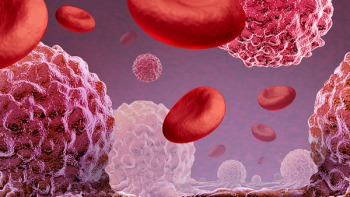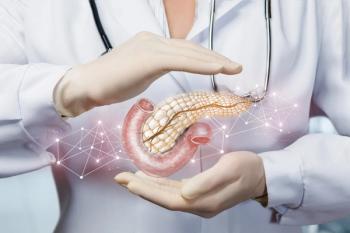
How a Blood Test May Help Guide Breast Cancer Treatment

Key Takeaways
- ctDNA can potentially guide surgical decisions in breast cancer patients post-neoadjuvant chemotherapy by predicting lymph node involvement.
- Machine learning models and the Signatera assay were used to assess ctDNA's predictive capabilities for lymph node status.
Dr. Rita Mukhtar sits down for a conversation with Dr. Joshua Sabari to discuss the potential use of ctDNA to guide breast cancer therapy.
The ability to use circulating tumor DNA (ctDNA) to guide surgical decision-making following neoadjuvant chemotherapy was explored in a presentation by researchers at the
In an interview following the meeting, Dr. Rita Mukhtar, one of the trial investigators, sat down for an interview with Dr. Joshua K. Sabari, editor-in-chief of CURE, to further explore ctDNA in this space. ctDNA are small pieces of DNA which can be detected and are released by tumor cells into a person’s blood; if detected early, they have the potential to guide treatment decisions, according to the National Cancer Institute website.
Mukhtar specializes in breast and general surgery and serves as an associate professor of surgery in the Division of Surgical Oncology at the University of San Francisco (UCSF), UCSF Health. Sabari serves as an assistant professor in the Department of Medicine at NYU Grossman School of Medicine and director of High Reliability Organization Initiatives at Perlmutter Cancer Center.
Sabari: Hello, I am Dr. Joshua Sabari. I’m a thoracic medical oncologist at NYU Langone Health, Perlmutter Cancer Center in New York. I’m excited to be joined by Dr. Rita Mukhtar, a breast surgeon. Rita, please introduce yourself.
Mukhtar: Thank you so much, I’m happy to be here. As you mentioned, my name is Rita Mukhtar, and I am a breast surgeon at UCSF. I also co-chair the local regional working group for the I-SPY2 trial, which is a neoadjuvant chemotherapy trial for patients with molecularly high-risk and low-risk breast cancer. We heard a lot of information at the meeting about the role of ctDNA in breast cancer, and it’s very exciting; there’s a lot of interest in ctDNA to guide systemic therapy and possibly for surveillance.
What I talked about was some exciting data where we actually looked at whether or not ctDNA can help us plan our surgical approach for patients with breast cancer. We looked at patients who had neoadjuvant chemotherapy, and ctDNA was measured before chemotherapy, during and after. Then people went to the operating room, and typically for breast cancer surgery, at least a few lymph nodes are removed. If any of those lymph nodes still have tumor after chemotherapy, then patients undergo axillary lymph node dissection, which involves removing the majority of lymph nodes in the axilla or armpit area, and that can cause significant morbidity, such as lymphedema.
What we really want to find is a way to figure out which patients are only going to have maybe one or two positive lymph nodes. When you do that sentinel node biopsy, you’ve already gotten everything out, and you don’t need to go on and remove any more lymph nodes. We don’t have a great way of figuring that out right now, but it turns out that ctDNA can predict whether or not someone has a high chance or a low chance of having many lymph nodes that are still positive after chemotherapy. This is a model that we developed using machine learning; it’s something that we’re going to have to validate for sure. We looked retrospectively at patients who have participated in the I-SPY trial, but we are in the process of validating this further.
These data kind of open the door to the idea that we might be checking ctDNA before we go to the operating room, and based on the result of that, deciding if we’re going to do just a sentinel node biopsy or the full axillary dissection. The other exciting thing is that we could also change the endpoints in the model. In the model that we used, we really predicted having a high nodal burden, but you could also predict having negative nodes.
If we could use ctDNA to help us be highly confident that people did not have any involved lymph nodes, we maybe could even omit all axillary surgery in these high-risk patients who are getting neoadjuvant chemotherapy.
Sabari: Thank you, Dr. Mukhtar, that was a phenomenal presentation and truly important for guiding patient care, particularly in the operating room. I know in the lung cancer space, we use a lot of ctDNA in both the early-stage and metastatic settings. How sensitive are the assays that you’re using in patients with breast cancer?
Mukhtar: There’s been a huge evolution in the use of ctDNA assays, starting with the genotyping assays often used in the metastatic setting. What we’re using now are these MRD, or minimal residual disease, assays in the non-metastatic setting. These new generation assays can detect tumor DNA in the blood down to one part per million.
Certainly, assessing the sensitivity of the assay being used is important when evaluating the data and also when considering which assays to use going forward, depending on the setting. We used the Signatera assay. The Signatera assay is a tumor-informed assay, meaning the patient’s primary tumor is sequenced, and up to 16 tumor-specific mutations can be used to create a probe to look for that circulating tumor DNA in the blood.
If patients have detection of at least two of those mutations, we classify that as positive. We used positive or negative as the endpoint or predictor in our study, but you could also look at the quantity because these are quantitative assays.
Sabari: That is so important. Thank you for your work; I’m looking forward to seeing ongoing validation so that it can change practice for our patients with breast cancer. I’m joined again by Dr. Rita Mukhtar, breast surgeon, and thank you for joining us and for participating and educating our CURE readers. Thank you.
Mukhtar: Thank you so much. It’s a pleasure to be here.
For more news on cancer updates, research and education,





